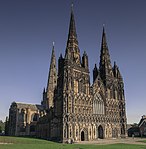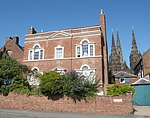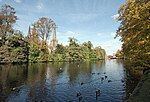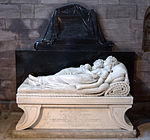Cathedral Close, Lichfield
Harv and Sfn no-target errorsLichfield Cathedral

The Cathedral Close is a historic set of buildings surrounding Lichfield Cathedral in Lichfield in the United Kingdom. The Close comprises buildings associated with the cathedral and the clergy which encircle the Cathedral. The Close grew up around the cathedral during medieval times and today some medieval buildings remain in the Close but the majority of buildings date from the 17th, 18th and 19th centuries.
Excerpt from the Wikipedia article Cathedral Close, Lichfield (License: CC BY-SA 3.0, Authors, Images).Cathedral Close, Lichfield
The Close, Lichfield Dimbles
Geographical coordinates (GPS) Address Nearby Places Show on map
Geographical coordinates (GPS)
| Latitude | Longitude |
|---|---|
| N 52.684964 ° | E -1.831758 ° |
Address
The Close
WS13 7LF Lichfield, Dimbles
England, United Kingdom
Open on Google Maps









